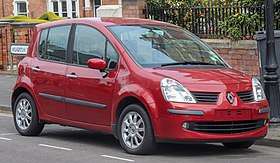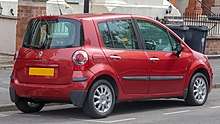Renault Modus
The Renault Modus is a mini MPV produced by the French manufacturer Renault from August 2004 to December 2012, in Valladolid, Spain. The production version is very similar to the concept car of the same name, which was presented at the 2004 Geneva Motor Show. It is essentially a taller version of the Clio III and, as such, shared its platform and much of its engine range with the third generation of the Clio.
| Renault Modus | |
|---|---|
 | |
| Overview | |
| Manufacturer | Renault |
| Also called | Renault Grand Modus |
| Production | 2004–2012 |
| Assembly | Spain: Valladolid (Renault Spain) |
| Body and chassis | |
| Class | Mini MPV (M) |
| Body style | 5-door mini MPV |
| Layout | Front-engine, front-wheel-drive |
| Platform | Alliance B platform |
| Related | Renault Clio Nissan Cube Nissan Note |
| Powertrain | |
| Engine | 1.2 L 16-valve I4 (petrol) 1.2 L 16-valve TCe I4 (petrol) 1.4 L 16-valve I4 (petrol) 1.6 L 16-valve I4 (petrol) 1.5 L dCi I4 (diesel) |
| Transmission | 5-speed manual 6-speed manual 4-speed automatic 5-speed semi-automatic |
| Dimensions | |
| Wheelbase | 2,482 mm (97.7 in) (Modus)[1] 2,575 mm (101.4 in) (Grand Modus)[2] |
| Length | 3,792 mm (149.3 in) (Modus) 4,034 mm (158.8 in) (Grand Modus) |
| Width | 1,695 mm (66.7 in) |
| Height | 1,590 mm (62.6 in) |
| Chronology | |
| Successor | Renault Captur Renault Scénic IV |
A larger wheelbase version was produced as the Renault Grand Modus. Originally marketed as "a higher-range alternative to the Twingo and Clio", it aimed to provide the practicality and versatility of the larger Renault Scénic in a smaller footprint. The Clio platform that spawned the Modus also gave rise to the current Nissan Micra and its monospace relative, the Nissan Note.
In February 2012, Renault discontinued the Modus, Espace, Kangoo, Laguna, and Wind lines in the United Kingdom.[3]
Design features

Marketed as the Triptic System, the Modus' rear seats are mounted on sliding rails with four preset positions. When in the rearmost two positions the seats are configured for two people with increased leg, hip and shoulder room. When in the forward positions they are configured for three passengers, increasing cargo capacity.
Another seat based feature of Modus is the "Stay Put" system. The base of the front passenger seat flips up to reveal a storage compartment. An optional feature of the Modus is a boot chute, a drop down opening in the centre of the tailgate below the rear window.
The facelifted Modus was launched in Europe in 2007, featuring colour coded bumpers on all versions, clear Perspex 'glass' indicator bezels, revised side door mouldings and updated interior trim on all specification levels.
Restyle
Soon after, in February 2008, a restyled Modus and new the Grand Modus were launched. Also that year, the Grand Modus replaced the Modus in Spain. The Grand Modus has an extended length of 4,034 mm (158.8 in) and a boot volume of 410 litres (0.41 m3 (0.54 cu yd)) below the parcel shelf.
This restyle saw changes made to the front and rear of the standard model to match the styling of the newer Grand variant. The boot chute has been removed from the options list.
Safety
The Modus was the first small car to receive the full 5 Euro NCAP stars for passenger safety due in part to its six airbag system, front and rear side impact bars and ISOFIX child seat fixing points. It was also one of the first cars in its class to have such features as automatic headlamps and windscreen wipers on its options list.
The Modus was offered with a cornering lamp function. Concealed in the main headlamp unit and operating at speeds less than 38 mph (61.2 km/h), the lights gave the driver a wider field of vision when going round bends. On Privilège and Initiale models, Renault offered the Modus with "double distance" Xenon headlamps.
Mechanicals
Phase I
| model | engine type | max. power | rpm | max. torque | rpm | top speed | 0–100 km/h (62 mph) | mpg | CO2 emissions[4] |
|---|---|---|---|---|---|---|---|---|---|
| petrol engines all fuel injected | |||||||||
| 1.2 16v | I4 SOHC | 75 PS (55 kW; 74 hp) | 5500 | 104 N⋅m (77 lbf⋅ft) | 4250 | 101 mph (162.5 km/h) | 13.5 sec | 47.0 | 145 g/km |
| 1.4 16v | I4 DOHC | 100 PS (74 kW; 99 hp) | 5700 | 127 N⋅m (94 lbf⋅ft) | 110 mph (177.0 km/h) | 11.4 sec | 42.3 | 161 g/km | |
| 1.6 16v | I4 DOHC | 113 PS (83 kW; 111 hp) | 6000 | 151 N⋅m (111 lbf⋅ft) | 117 mph (188.3 km/h) | 10.3 sec | 41.6 | 163 g/km | |
| 1.6 16v Auto | 114 mph (183.5 km/h) | 12.3 sec | 37.8 | 182 g/km | |||||
| diesel engines all Direct Injection (dCi) | |||||||||
| 1.5 dCi | I4 SOHC Turbo | 68 PS (50 kW; 67 hp) | 4000 | 160 N⋅m (118 lbf⋅ft) | 2000 | 96 mph (154.5 km/h) | 15.3 sec | 60.1 | 125 g/km |
| 86 PS (63 kW; 85 hp) | 3750 | 200 N⋅m (148 lbf⋅ft) | 1900 | 106 mph (170.6 km/h) | 12.6 sec | 62.8 | 119 g/km | ||
| 106 PS (78 kW; 105 hp) | 4000 | 240 N⋅m (177 lbf⋅ft) | 2000 | 116 mph (186.7 km/h) | 11.2 sec | 60.1 | 124 g/km | ||
Phase II
| model | engine type | max. power | rpm | max. torque | rpm | top speed | 0–100 km/h (62 mph) | mpg | CO2 emissions[4] |
|---|---|---|---|---|---|---|---|---|---|
| petrol engines all fuel injected | |||||||||
| 1.2 16v | I4 SOHC | 75 PS (55 kW; 74 hp) | 5500 | 104 N⋅m (77 lbf⋅ft) | 4250 | 101 mph (162.5 km/h) | 13.5 sec | 47.9 | 138 g/km |
| 1.2 16v QS5* | 105 mph (169.0 km/h) | 15.0 sec | 50.4 | 134 g/km | |||||
| 1.2 TCe | I4 SOHC Turbo | 100 PS (74 kW; 99 hp) | 5500 | 145 N⋅m (107 lbf⋅ft) | 3000 | 113 mph (181.9 km/h) | 11.2 sec | 47.1 | 139 g/km |
| 1.6 16v Auto | I4 DOHC | 113 PS (83 kW; 111 hp) | 6000 | 151 N⋅m (111 lbf⋅ft) | 4250 | 114 mph (183.5 km/h) | 12.3 sec | 36.7 | 179 g/km |
| diesel engines all Direct Injection (dCi) | |||||||||
| 1.5 dCi | I4 SOHC Turbo | 88 PS (65 kW; 87 hp) | 4000 | 200 N⋅m (148 lbf⋅ft) | 1750 | 106 mph (170.6 km/h) | 13.0 sec | 62.8 | 107 g/km |
| 1.5 dCi QS5* | 14.8 sec | 119 g/km | |||||||
- QS5 = QuickShift5
In terms of reliability, according to the 2006 breakdown survey from the German Automobile Club,[5] the Modus ranks 3rd in its class with an average 5.8 breakdowns per 1,000 vehicles after three years. This is behind the Audi A2 (1st) and the BMW Mini (2nd) and ahead of the Lupo (4th) & Polo (5th), Toyota Yaris (6th) and Honda Jazz (7th).
See also
- Renault Scénic, the compact MPV of the manufacturer
- Renault Espace, the large MPV of the manufacturer
References
- http://www.auto-types.com/renault-modus-12-16v-65-acces-5-doors-mpv-5-speed-manual-56195.html
- http://www.auto-types.com/renault-grand-modus-12-16v-authentique-5-doors-mpv-5-speed-manual-56177.html
- "Renault to cut five UK models". telegraph.co.uk. 19 December 2011.
- "Renault Modus - technical". carinf.com. 2012-10-11. Retrieved 2012-10-11.
- "ADAC Pannenstatistik 2006" (PDF). ADAC. 2011-09-21. Archived from the original (PDF) on March 6, 2009. Retrieved 2009-03-06.